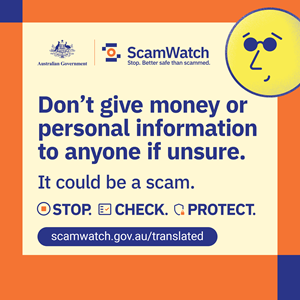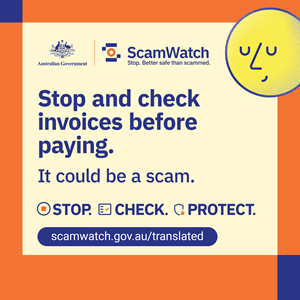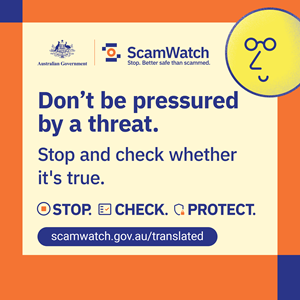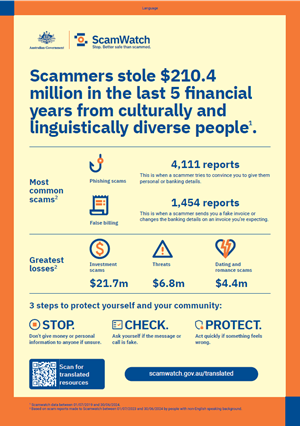[This is an English version of scams information in other languages. See the Scamwatch homepage for more information and resources in English.]
Scams are everywhere, targeting people from all walks of life and costing Australians billions of dollars each year. Whether it’s fake emails, unexpected phone calls or online schemes, scammers always find new ways to gain your trust and steal your money or personal information. But 3 simple steps can help keep us all safe from scammers.
On this page
Three steps to protect yourself from scams
STOP.

Don’t give money or your information to anyone if unsure.
Scammers will offer to help you or ask you to verify who you are. They will pretend to be from organisations you know and trust like businesses, the police, your bank or government services.
CHECK.

Ask yourself - could the message or call be fake?
Never click a link in a message. Only contact businesses or government using contact information that you find yourself from their official website or app. If you’re not sure, say ‘no’, hang up or delete.
PROTECT.

Act quickly if something feels wrong.
Contact your bank if you notice unusual activity or if a scammer gets your money or information. Seek help and report the scam to us. When you report scams, you help us stop the scam and warn others.
These materials in English can help you recognise and avoid scams.
How to spot and avoid scams
The How to Spot and Avoid Scams publication is recognised internationally as an important tool for people and small businesses to learn about scams, including:
- the most common scams to watch out for
- the different ways scammers can contact you
- the tools scammers use to deceive you
- the warning signs
- how to defend against scams
- where you can find help.
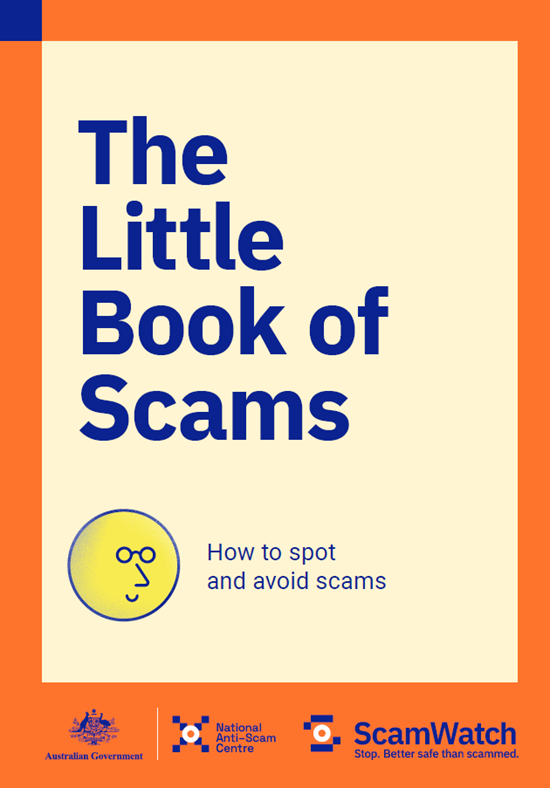
The Little Book Scams helps you learn about the most common scams, how scammers try to deceive you, and how to protect yourself
Video
This video in English explains some of the ways you can protect yourself and your community from criminal scammers and learn more about Scamwatch.
Scamwatch is led by the National Anti-Scam Centre.
Scamwatch shows you how to spot and avoid scams.
When we’re alert, we’re in control.
We know when to stop and check if someone really is who they say they are.
Scammers are getting smarter and coming up with new scams all the time.
Scammers will make you feel you need to respond or act quickly.
They hope that by putting this pressure on you,
they will make you miss the warning signs of a scam.
So, what are these warning signs?
They might be: Threats or accusations from authority.
Opportunities to make money.
Stories or cries for help.
Requests to open links or attachments.
Asking you to pay in unusual or specific ways
or directions to transfer money to a ‘safe account’.
Scammers will often pretend to be from organisations you know
or individuals you trust.
Like service providers, the police,
your bank, the government,
or even a family member.
They can contact you in many different ways.
Like text/SMS, email, phone calls,
website, social media and online messaging or apps.
There are three simple steps you need to remember to protect yourself:
STOP – Don’t rush to act.
Remember, scammers will create a sense of urgency.
CHECK – Ask yourself, could this message or call be fake?
Do you really know who you’re communicating with?
REPORT – Act quickly if something feels wrong,
and help others in your community by reporting scams to Scamwatch.gov.au.
If you have transferred money or shared any financial information,
contact your bank immediately.
Anyone can be scammed.
If you or anyone you know has had money or personal information stolen in a scam,
you are not alone.
Talk to your family, friends and community about scams.
And Remember to STOP!
You’re better safe than scammed.
There's no shame in getting scammed
It can happen to any of us. We encourage you to share information and your personal scam experiences with your friends, family and community. This can help to prevent someone else from having their money or personal information stolen. The more we talk, the less power scammers have.
Get involved in fighting scams
Promote Stop. Check. Protect . - the 3 simple steps to keep us all safe from scams, in your workplace, community or family using these posters, images and audio clips.
Social media post – phishing scams
Share this social media post to help others identify phishing scams.
Scammers pretend to be businesses you trust like banks, and internet or phone services.
They’re trying to get your personal information so they can steal your money and commit other crimes.
Next time you receive an email or message requesting information, Stop. Check. Protect.
For more scam information, visit www.scamwatch.gov.au/translated
Social media post – fake invoice scams
Share this social media post to help others identify invoice scams.
Scammers pretend to be from a business you’ve used before and send you an invoice with fake payment information.
The best way to protect yourself is to call the business to confirm the payment and bank details. Make sure to use the phone number you already have, not the phone number on the invoice.
For more scam information, visit www.scamwatch.gov.au/translated
Social media post - impersonation scams
Share this social media post to help others identify impersonation scams.
The Australian Government won’t threaten you, but scammers will.
Scammers can steal private information and impersonate an individual or organisation.
Sometimes they’ll even threaten you with arrest, deportation, or physical harm, if you don’t agree to pay them immediately.
Check that the person is who they say they are by calling the organisation back using contact details you find through an internet search.
For more scam information, visit www.scamwatch.gov.au/translated
Audio recording - phishing scams
From July 2019 to June 2024, Scamwatch received more reports on phishing from people with a non-English speaking background than any other scam type.
Phishing scams are attempts to deceive you into sharing your personal information, via a message or email. Phishing scams look real because scammers usually impersonate organisations you know. They often misuse real logos and ABNs, and make it look like the phone number or email address they’re contacting you from is the same as the real organisation's. They may also create a sense of urgency by providing a fake deadline or threatening you with a penalty if you don’t respond.
Before sharing any personal or financial information, always call the organisation’s official phone number to check the message is real.
[End of transcript]
Audio recording - threat and extortion scams
Between July 2019 and June 2024, people with non-English speaking backgrounds reported losing $6.8 million to threat and extortion scams.
Scammers pretend to be from an organisation or government agency and claim you need to pay them money. They may threaten you with arrest, deportation, or even physical harm, if you don’t agree to pay.
They can also blackmail you by threatening to share intimate pictures or videos of you unless you send them money.
In some cases they have forced students to fake their own kidnapping, to deceive their family into sending a ransom.
Don’t be pressured by a scammer. They are trying to scare you into doing what they say. Report to Scamwatch or if you are worried about your safety, contact the police immediately.
[End of transcript]
Audio recording - Stop. Check. Protect.
From July 2019 to June 2024, people from a non-English speaking background reported over 62,000 scams to Scamwatch; losing a total of $210.4 million.
You can keep yourself safe from scams with 3 simple steps:
Step 1: STOP – Don’t give out personal information or money if you are unsure. Say no, hang up and do not click any links.
Step 2: CHECK – Scammers pretend to be from organisations you know – such as your bank, the police or government services. Always contact the organisation using information that you find yourself on their official website or app.
Step 3: PROTECT – Act quickly if something feels wrong. Contact your bank if a scammer gets your money or information, and report to Scamwatch.
[End of transcript]
Poster - scam statistics
This poster shows how scams are impacting culturally and linguistically diverse communities in Australia.
Report scams
Reporting a scam to Scamwatch gives us information about the latest scams so we can identify and disrupt them. It helps us warn the community of new or emerging scams and enables us to share this information with law enforcement and other government organisations to help them investigate and prosecute scammers.
Our online reporting form is in English. If you need to report a scam in another language, you can call the Translation and Interpreter Service on 131 450 and ask them to connect you with our Scamwatch team (on 1300 302 502). Our staff will be happy to record your scam report with the help of an interpreter.




